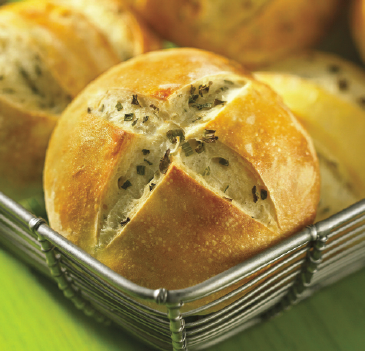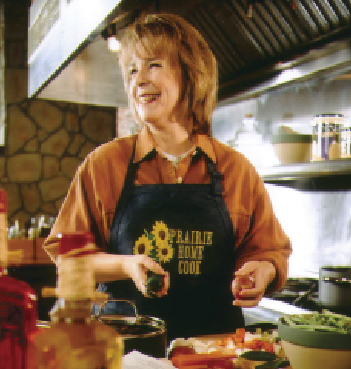
lighting a fire
December 16, 2009
By
Brian Hartz
Can artisan bread baking be fast and easy? Recipe editor and baking
instructor Judith Fertig thinks so. Her latest cookbook, 200 Fast &
Easy Artisan Breads, seeks to make this time-honoured form of baking
more accessible and approachable.

|
|
| Artisan breads on display at the Europain bakery trade show in Paris.
|
Can artisan bread baking be fast and easy? Recipe editor and baking instructor Judith Fertig thinks so. Her latest cookbook, 200 Fast & Easy Artisan Breads, seeks to make this time-honoured form of baking more accessible and approachable.
Potential consumer trends aside, members of Canada’s Artisan Bakers Quality Alliance (ABQA) say “not so fast.” They have joined forces with George Brown College’s Centre for Hospitality and Culinary Arts in developing the new Artisan Baking Skills Certificate. Designed for those who are working for or pursuing employment with an artisan baking organization, the program includes a distance-learning course – Fundamental Theory of Artisan Baking – as well as some online and on-site courses.
According to the ABQA website: “ABQA artisans bake breads that are rich in nutrition and taste. They are made with a culture (sourdough or starter) and given an uncommon amount of time to rest. The result is bread that has a special combination of texture and complex flavour, and a moist crumb that is unique to sourdough bread. As with fine wine or cheese, the flavour and mouth-feel of bread comes from maturing the dough, and the natural fermentation process.”

|
|
| Roquefort and Walnut Fougasse, one of Judith Fertig’s recipes. | |
 |
|
| Artisan breads on display at the Europain bakery trade show in Paris. | |
 |
|
| George Brown College baking and pastry arts instructor Erica McClellan works with student Ricky Lam. | |
 |
|
| A range of artisan breads made by students at George Brown College in Toronto. | |
 |
|
| Judith Fertig’s Buttermilk Chive Rolls.
|
Educating aspiring bakers
At the launch of the new artisan-baking program on Sept. 24 at George Brown College, ABQA members spoke about what they’re trying to accomplish in this partnership with the college, which, coincidentally, remodelled its baking and pastry labs over the summer.
“ABQA formed five or six years ago, but changed its mandate about two years ago to be more involved in education, and we thank George Brown for helping us with that,” said ABQA president Shasha Navazesh. “We thought it would be better to get involved with the education of new staff in the industry than to try to promote and enforce a voluntary standard [for artisan baking].”
The Artisan Baking Skills Certificate will focus on the essential skills and theories required to take an active role in the artisan baking industry, including common baking practices, safety and sanitation skills, and cultural approaches to artisan baking.
“In this program, the lab sessions will be set up for small-batch baking of hearth-style breads,” said GBC instructor Jennifer Lakhan-D’Souza. “Students will learn a little bit of everything and get a sense of how different breads can be. The focus will be slow, fermented, old-fashioned baking – the basics.”
What is artisan baking?
In light of this development and the publication of Fertig’s book, a conference call with members of the Bakers Journal editorial advisory board included a spirited discussion about artisan baking, its future and how it is – or should be – defined.
Vikram Chowdhury, marketing manager for Puratos, which produces a range of mixes and bases, indicated that the growth of artisan baking is being held back by its lack of definition.
“The small bakers on the street corners in Europe are using our products,” he said. “Does that make them not artisan?”
However, Chowdhury said, artisan baking’s strength lies in its emphasis on tradition – it’s simply a matter of educating the consumer about the benefits.
“In Belgium, they did a study in which they talked to a futurist, who said bakery’s future is in its past,” he said. “But the main problem we’re noting with artisan bakeries here is the lack of time to go out and shop. The consumer would rather go to the supermarket and do all their shopping in one trip. The North American shopping model is based on convenience and quickness.”
Artisan Bakery Café head baker Richard Crossman reports strong growth in artisan breads, especially among companies that, due to the recession, are opting for on-site catering rather than going out for extravagant lunches.
“It’s really started to pick up. Our catering orders are up about 25 per cent since Sept. 1,” he says.
At the individual retail level, Crossman says, “People are willing to pay for about anything if they know they’re getting a wholesome product. For example, our new chia bread is taking off like gangbusters. We bake 500-600 loaves per week and I’d estimate about 75-80 of those are chia bread.”
Navazesh, the ABQA president and founder and CEO of Shasha Bread Co., in Toronto, is not surprised by the growth of the artisan bread market – or the wrangling over its definition. What Fertig is doing, he explains, “Looks artisanal, but it’s not. If you don’t ferment for at least four hours, the gluten won’t form properly and the bread won’t be as digestible – you won’t have the lactic acid that contributes to digestibility, and complex flavour will only develop partially after four hours. If you want to have the slightest difference between artisan and regular bread, you must have four hours.”
Beyond the niche
Navazesh’s bakery was incorporated in 1999, when, according to the Toronto Star, its sales reached $1 million. In the years since, that figure has more than doubled, despite his loaves of bread taking up to 18 hours to produce – as opposed to 60 minutes for standard, commercially made bread.
“We have our niche and we perfect what we do,” Navazesh told the Star.
But is it really still a niche product?
“Artisan bread has gained so much market share recently,” Navazesh says. “In the past four years, one grocery category that has grown more than any other is artisan bread and specialty bread. I think it’s somewhere around 25 per cent. Remember when grocery store bread never used to be marked up? Now things have changed. You can spend $8 on a loaf of bread. Grocery stores are making a lot more profit on it.”
The ABQA can claim some credit for that, as member businesses such as Shasha, Fred’s Bread, Future Bakery and Backerhaus Veit have willingly shared formulas among fellow artisan bakeries.
“He feels that as the public appetite grows for artisan bread, everyone in the industry will profit,” the Star wrote.
What the ABQA aims to do, Navazesh says, is recreate and nurture “the ancient techniques of traditional sourdough baking – that is, baking without commercial yeast using a natural sourdough culture: the unique combination of bacteria and fungus.
“Sourdough techniques have existed for thousands of years and nowadays attract more attention from consumers than ever before because of their wholesome process, with clean raw materials, great nutritional profile and unique aroma and texture.
“But if you keep it a niche market the price will be so high that it won’t grow. It has to be pushed into the mainstream to bring the price down. If we can educate the public through government and the manufacturers through venues like Bakers Journal, they’ll pick it up and people will buy it.”

|
|
| Recipe editor, baking instructor and cookbook author Judith Fertig.
|
Judith Fertig explains ‘fast and easy’ method
Judith Fertig has formulated a basic dough that can be used in dozens of different recipes, but whether it’s a consumer approach that will affect a profitable niche among industrial bakers is yet to be seen. Unlike the complex process required for traditional artisan bread, the dough requires only one bowl, basic utensils and equipment, and no kneading.
The ingredients are equally simple: unbleached, all-purpose or bread flour; instant or bread machine yeast; fine table or kosher salt; and lukewarm water. In this and other recipes that call for such flour, she courteously includes reminders about the difference in protein content between the Canadian and U.S. varieties.
“I started with that one template dough and went from there. If you can master this one simple recipe, a whole huge door of baking opens up for you.”
But doesn’t the “fast and easy” mindset go against the essence of artisan baking? Not really, says Fertig.
“This new method for artisan bread is fast when you consider the hands-on part of the process,” she replied. “You don’t have to sprinkle yeast over water to proof it – you just stir instant or bread machine yeast into the flour, so you save a step there. You stir the ingredients together in a bowl and this takes – if you’re very, very slow – about two minutes. Then the dough rises for two hours, but you’re free to do other things. Then, you have nine days to shape and bake it. (You could also shape and bake the same day.)”
With Fertig’s methods, “You’re in charge of the bread; the bread’s not in charge of you,” she says. “The dough can sit for up to nine days, and it can be frozen.”
During her Toronto appearance, Fertig exhorted the aspiring bakers in attendance to “make these breads look rustic. If they look too professional, nobody will believe you made them!”
At the risk of stirring up a hornet’s nest of opinions on the subject, Fertig’s perspective begs the question: Just what is artisan baking? Is it the look of the bread? The taste and texture? The process and ingredients? There are any number of answers – probably as many as there are bakers in this country.
Stay tuned …
On the web: Artisan Bakers Quality Alliance: www.abqa.com
Print this page
Leave a Reply